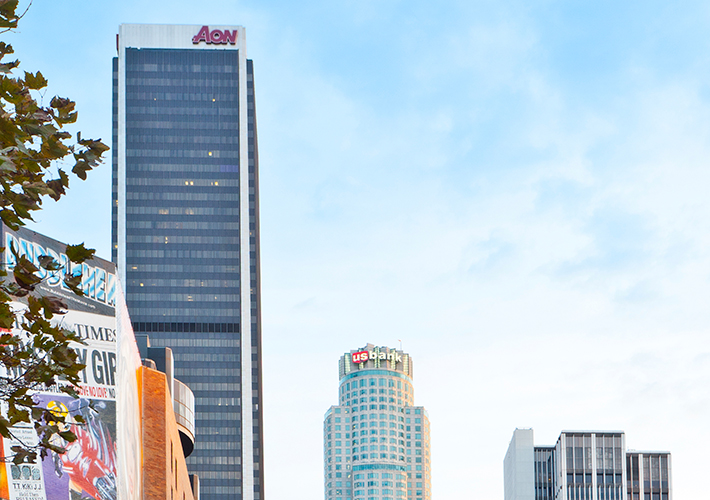
Silent Heroes
Fire safety standards, and especially the fire-resistant materials they cover, serve as unseen sentinels protecting life and property.
Exactly 27 years ago, in May 1988, a major fire broke out at the First Interstate Tower in Los Angeles. A 1991 film, "Fire: Trapped on the 37th Floor," captured the dramatic story. The fire killed one person and injured 40 more. It destroyed five floors of the building, causing $50 million in damage.
The fact that the 62-story building lived to see another day (it is now known as the Aon Center) is thanks in part to fireproofing applied to structural steel and tested in accordance with ASTM's methods for fire tests of building construction and materials (E119). In other words, the damage and loss of life could have been much greater without standards.
However, the fire also highlighted design shortcomings at the junction of the curtain wall and the floors, according to Sarah Brewer, fire protection sales and marketing manager at Unifrax and chair of ASTM's Subcommittee on Fire Resistance (E05.11). She explains that in curtain wall construction, there is always a joint between the façade and the structure, leaving a linear gap. "In the case of the First Interstate Tower, the fire spread vertically several floors because the fire protection in those gaps was inadequate," she says.
Systems Working Together
To make a safe building, all systems must play their part, explains Bill McHugh, executive director of the Firestop Contractors International Association. This includes fire resistance-rated construction (including effective compartmentation), detection/alarm systems and sprinklers, as well as occupant education about emergency exits (egress systems). "They need to work together to protect people and property in buildings," he says.
In particular, notes McHugh, fire resistance-rated construction - made possible through standards - is the "silent hero." While alarms, sprinklers and exits are all highly visible to building occupants, the less visible, fire-resistant parts of the building are just as important, including:
- Floor assemblies made from concrete or combination wood-and-gypsum;
- Structural steel columns;
- Fireproofed beams and floors; and
- Wall assemblies made from concrete, concrete block or gypsum.
All of these construction materials are tested to standard E119 and, when they comply, have remarkable powers of fire resistance, a critical factor in ensuring occupant safety.
Another key fire test standard used for ensuring building safety is the test method for surface burning characteristics of building materials (E84), also known as "the Steiner tunnel test." The tunnel test "is used for everything under the sun" to assess the flame spread and smoke characteristics of the materials used in buildings, according to Marcelo Hirschler, Ph.D., president of GBH International and an active ASTM member in this field.
Hirschler says that, over the years, many testing exceptions to E84 have been implemented to adapt to newer materials in areas such as wall coverings and insulation. For example, one variation of E84 tests materials such as fire-retardant treated wood for an extended period of time (E2768).
Tests and Inspections
ASTM standards and tests are used to support the safety of many materials. In particular, firestopping tests use time and temperature to approximate a real fire, McHugh explains. Key elements include:
- A fire endurance test resulting in "F" or "fire rating," in which failure occurs if a breach allows the flame to reach the unexposed side of the sample;
- A temperature-rise test resulting in a "T-rating," in which the unexposed side of the assembly is tested to protect against fire spread without a breach; and
- A hose stream test after fire exposure to simulate things falling during a fire and hitting a material or assembly.
Standards used in this area include the test method for fire tests of penetration firestop systems (E814) and the test method for fire-resistive joint systems (E1966).
In addition, ASTM standards are used in the field by inspectors. Two are particularly notable because they are part of Chapter 17 (Special Inspections) of the International Building Code:
McHugh notes that when a well-trained firestop contractor (e.g., FCIA member, FM 4991 approved or UL qualified) is used in conjunction with ASTM inspection standards, safe buildings are the result and the best value for all involved.
Looking Forward
Standards development in this area can never stand still. Major fire events like the First Interstate Tower show the need for a continual review of ASTM standards to ensure they remain relevant to the latest construction techniques as well as evolving understanding of how to evaluate the fire-performance features of materials and systems.
As an example of this, Brewer notes that there is a standard under development right now to address the threat of a fire bursting out of a wall or window and "leapfrogging" vertically to other floors (WK30656, New Test Method for Determining the Fire Resistance of Building Perimeter Containment Systems Due to External Spread of Fire).
That's just one example of the wide-ranging and important work of ASTM Committees E05 on Fire Standards and E06 on Performance of Buildings, which continue to develop standards to help reduce the potential for fire.
Alan Earls is a writer who covers business and technology topics for newspapers, magazines and websites. He is based near Boston, Mass.
 SN Home
SN Home Archive
Archive Advertisers
Advertisers Masthead
Masthead RateCard
RateCard Subscribe
Subscribe Email Editor
Email Editor